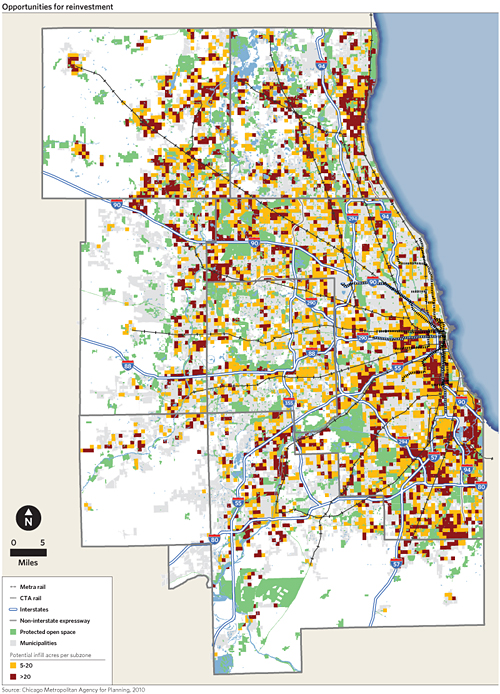One of the GO TO 2040 plan's primary goals is for the region to redevelop more than 100,000 acres of currently vacant or under-used land, which is ripe for a mix of residential and commercial uses that would help strengthen our existing communities. A good portion of the land available for redevelopment exists near public transit station areas and is zoned for manufacturing or commercial purposes, making it attractive for new business. The Center for Neighborhood Technology's (CNT) report "Next Stop: New Jobs" focuses on this potential. CNT used a GIS application they call the Employment Opportunity Optimizer Analysis tool to calculate prospective job creation in greater Chicago's neighborhood transit zones, highlighting over 50 station areas with opportunities for economic development within manufacturing and commercial sectors. While the region's public transit system helps in reducing congestion and greenhouse gas emissions, it also can enable job development, which in turn "can lead to more destinations along a [transit] corridor, creating demand for transit outside of the central business district and, conceivably, in a reverse-commute direction," according to the report. The National Resources Defense Council staff blog Switchboard blogged about the CNT report in early March.
To learn more about the region's infill potential, visit MetroPulse and select the top-level "Land Use" topic to view details, including estimates by municipality within each of the seven counties of metropolitan Chicago (tracked by the indicator "Acres of Infill Potential"). This indicator tracks the number of acres considered to have potential for infill development based on the ratio of improvement (i.e., building) value to land value. Measuring acres of infill potential allows decision makers - including local officials and developers -- to track the existing stock of underutilized building sites throughout the region and prioritize development in these areas. Also, the efficient use of already-urbanized land is an important aspect of preserving open space, another goal of GO TO 2040.
